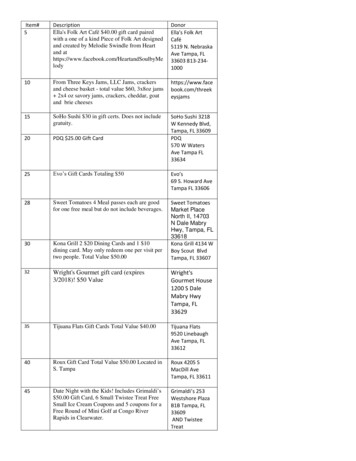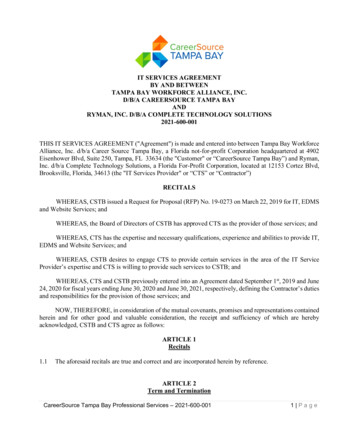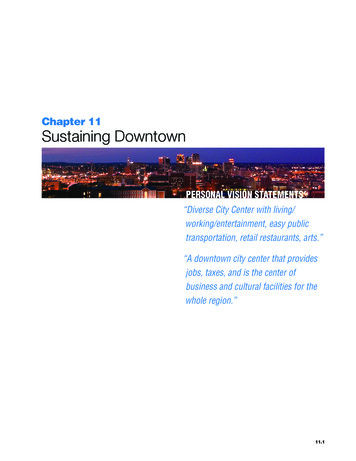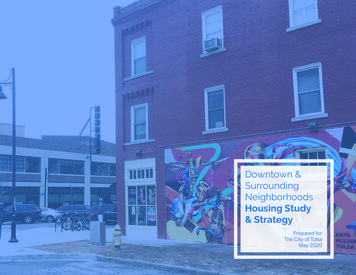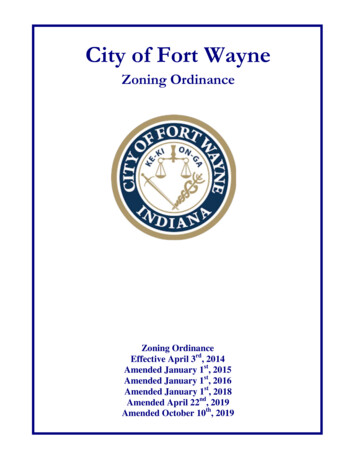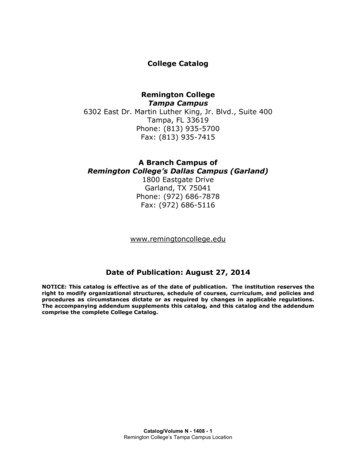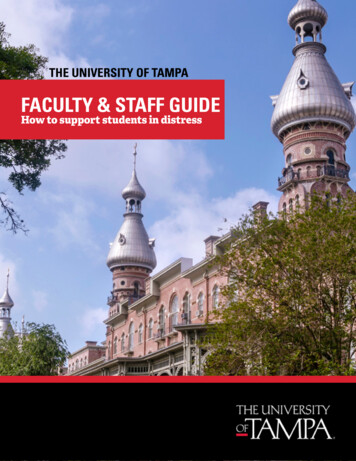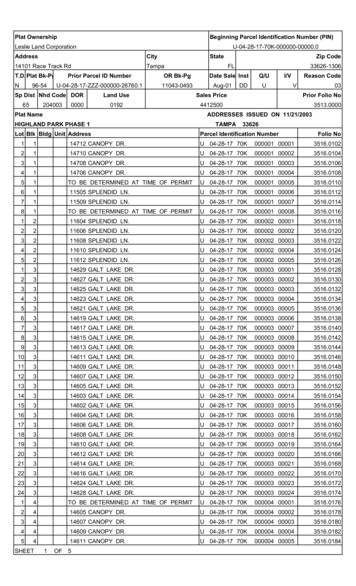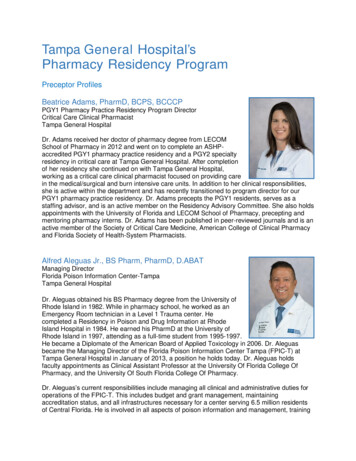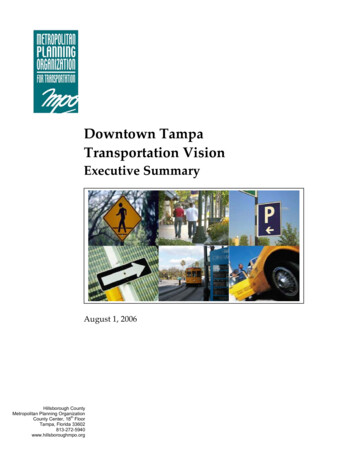
Transcription
Downtown TampaTransportation VisionExecutive SummaryAugust 1, 2006Hillsborough CountyMetropolitan Planning OrganizationthCounty Center, 18 FloorTampa, Florida 33602813-272-5940www.hillsboroughmpo.org
EXECUTIVE SUMMARYThe Downtown Tampa Transportation Vision is the product of a partnership betweenthe Hillsborough County Metropolitan Planning Organization (MPO); City of Tampa;government agencies; downtown organizations; and Tampa residents, employeesand visitors. Initiated by the MPO, the transportation vision was developed over a12-month period.The Downtown Tampa Transportation Vision provides a framework for theimplementation of transportation strategies that will address current and futuremobility needs within Downtown Tampa while addressing the diverse interests andvalues of the downtown community. Complimenting the land use and urban designstrategies defined within the Downtown Tampa Vision, completed in March 2005 bythe Tampa Downtown Partnership (TDP) and the City of Tampa, the objective of thetransportation vision is to provide guidance for future transportation and land usedecisions in order to achieve a safe, balanced and accessible downtowntransportation network that supports seamless connections for all modes of travel.While the Downtown Tampa Transportation Vision articulates a specific picture ofhow the transportation network within downtown should look and function, the visionserves as a living concept, remaining flexible to accommodate changing market andgrowth conditions while continuously working to improve the performance of thedowntown transportation network. The MPO will support ongoing efforts of the Cityof Tampa and agency partners to successfully implement the Downtown TampaTransportation Vision.PLANNING AREAThe planning area defined for this visioning effort includes the Tampa CentralBusiness District (CBD) and three surrounding sub-areas. The three districts includethe Cultural Arts District, East Tampa/Ybor and the Channel District. The study areais defined by the following boundaries: 22nd Street and Causeway Boulevard on the east, Martin Luther King, Jr. Boulevard on the north, Armenia Avenue and Howard Avenue on the west, and Areas north of the intersection of Bayshore Boulevard andHoward Avenue on the south.Page ES-1
PROJECT TEAM AND STAKEHOLDER COMMITTEEThe Downtown Tampa Transportation Vision was developed through the collaborationand partnership of the agencies and organizations composing the project team andthe stakeholder committee.The project team and stakeholder committee provided technical assistance in thetransportation visioning effort, facilitated public outreach activities and providedpolicy level input in the development of the vision policy recommendations. Themembers of the project team and stakeholder committee are charged withsupporting City of Tampa efforts in implementing the Downtown TampaTransportation Vision.PUBLIC OUTREACHThe public outreach activities pursued during the visioning effort provided valuableinformation in the development of the Downtown Tampa Transportation Vision. Afacilitated public workshop was conducted to document the concerns and desires ofthe general public regarding downtown transportation.Concerns voiced by the public include: High vehicle speeds, Lack of bike lanes and facilities, Limited transit service and routes, and Unsafe, uncomfortable environments for pedestrians and cyclists.Potential solutions expressed by the public to improve the downtown transportationnetwork include: Slow traffic, narrow streets and provide on-street parking; Provide lighting, shade and street furniture; Provide dedicated bike lanes, trail connections, as well as lockers andracks; Extend transit service hours and routes; and Use existing waterways for travel purposes.Page ES-2
The public also expressed the need for safe, convenient connections available to allindividuals (pedestrians, cyclists, transit riders, persons with disabilities, etc.)between downtown and surrounding areas.DOCUMENTED ISSUES AND OPPORTUNITIESIssues, needs and opportunities regarding downtown transportation services andfacilities and the character of the downtown street environment were identified bydowntown stakeholders through interviews, surveys and public involvementactivities.Key issues expressed by stakeholders regarding the downtown transportationnetwork include: Access and Circulation, Destination Connectivity, Pedestrian Mobility and Safety, Bicycle Mobility and Safety, Transit Service, Truck Traffic and Other Roadway Issues, Parking, Signalization, Signage, and Special Events Traffic.The following opportunities were expressed by the stakeholders to remedy the voicedissues: Establish a balanced system of east-west and north-south multi-modallinks to improve access, circulation and connectivity; Reduce vehicle travel speeds, increase crossing times at crosswalks,expand and connect sidewalks, and provide design elements toimprove pedestrian safety and mobility; Provide dedicated bicycle lanes, trails, racks on buses, storage racksand facilities to improve bicycle mobility and safety;Page ES-3
Provide regularly scheduled east-west and north-south downtowntransit circulators with convenient stops at key downtown attractions,increase hours of operation and extend routes to improve transitservice; Identify other preferred and efficient truck routes around downtown tosustain the business and residential character of the area; Study the implementation of the conversion of one-way streets to twostreets to improve multi-modal access, circulation and connectivitybetween downtown districts, neighborhoods and attractions; Identify downtown gateways to define the character of the downtownarea; Provide convenient and affordable parking structures and lots on theperiphery of downtown near gateways and key attractions, and servethese facilities with transit circulators; Review the current traffic signal timing system and adjust the trafficsignal times to reduce speeding and accommodate pedestrians,cyclists and transit; Update the wayfinding signage system so that it reflects the characterof downtown and surrounding areas, yet is also clear to both localsand tourists alike; and Use transit to connect remote parking to special event sites, establishaffordable parking and employ Intelligent Transportation System (ITS)technology at downtown entry points to inform motorists about delaytime and parking availability.PEER CITY REVIEWBest practices, goals and principles were compiled from downtown transportationmaster plans of five cities to inform the City of Tampa of successful strategies toconsider for improving the downtown transportation network. The five citiesincluded Austin, Texas; Hamilton, California; Raleigh, North Carolina; San Francisco,California; and St. Louis, Missouri.Page ES-4
Each plan promoted the following common themes: Pedestrian needs should govern downtown transportation and land usedecisions, Downtown streets should serve as places of social interaction, Active streets are well designed, Streetscape design elements should be scaled and oriented forpedestrian use, Ground level building uses should be required along downtown streets, and Downtown access and circulation should be improved by convertingone-way streets to two-way streets and establishing multi-modalconnections between the downtown core and surrounding districts,neighborhoods and attractions.POLICY AND GUIDELINE REVIEWExisting City of Tampa codes and land development regulations, applicable within theCentral Business District and the surrounding CBD environs, were examined toidentify policies supporting the Downtown Tampa Transportation Vision, as well asthose needing modification to ensure the transportation vision is executed. Thereview focused on policies guiding building design, orientation, and use; public andprivate open spaces; public views; and parking as these elements influence thetransportation environment. The examination revealed that the majority of policiesneeded to achieve the Downtown Tampa Transportation Vision currently exist in thecodes and regulations of the City of Tampa.DOWNTOWN TAMPA TRANSPORTATION VISION COMPONENTSThe following components serve as the foundation of the Downtown TampaTransportation Vision. These components will guide the implementation of thevision.VISION STATEMENT AND GUIDING PRINCIPLESThe project team, the stakeholder committee and the public crafted a visionstatement and set of supporting guiding principles to direct future land use andtransportation decisions in order to achieve the Downtown Tampa TransportationVision.Page ES-5
The vision statement and guiding principles of the Downtown Tampa TransportationVision are presented as follows:VISION STATEMENT“Create a vibrant, pedestrian oriented downtownthat successfully connects people to placesthrough a safe, effective and accessibletransportation network supporting seamlessconnections for all modes of travel.”Page ES-6
GUIDING PRINCIPLES Implement the Downtown Tampa Transportation Vision to create asense of place, provide mobility choices and support vibrantneighborhoods Create pedestrian-oriented streets and places that are comfortable,safe and accessible to people with and without disabilities Use transportation assets to reinforce downtown as a destination thatevokes a sense of civic pride and to reflect the unique identity anddistinct character of the city and its designated downtown districts Maximize circulation and mobility within downtown Provide information to link people with places Provide and maintain multimodal access and connections to downtowndistricts, neighborhoods and attractions Maintain a sustainable and environmentally sound transportationnetwork Minimize conflict between vehicles, pedestrians and bicyclists Maintain and support downtown as a transit hub and passengerintermodal center Provide programs and facilities to manage congestionRECOMMENDED STRATEGIES AND ACTIONSThe recommended strategies and actions were developed to unite the efforts ofimplementing agencies in order to strengthen existing standards that regulate thedesign of streets, remedy current concerns regarding the downtown transportationnetwork, and ultimately attain the Downtown Tampa Transportation Vision.The recommended strategies serve as ongoing methods to achieve the guidingprinciples of the transportation vision. The recommended strategies are summarizedas follows: Annually review the Downtown Tampa Transportation Vision to confirmproject priorities and program funding for project implementation; Implement pedestrian-friendly transportation design; Maintain a street grid pattern;Page ES-7
Develop and implement a transportation marketing strategy tomaximize the use of available multi-modal facilities and services; Update wayfinding system through the coordination of transportationand downtown agencies; Enhance the Intelligent Transportation System (ITS) strategy fordowntown to inform people about traffic conditions, transit operationsand services, parking availability and special events; Coordinate land use and transportation planning; Provide two-way streets where appropriate based on engineeringanalysis; Develop and maintain strong linkages to the Riverwalk; Provide multi-modal links and facilities between activity centers; Plan for future transit investments; Promote the Port of Tampa as a major passenger intermodal center; Employ transportation demand management to encourage the use ofalternative transportation modes; Minimize congestion during special events; Provide a functional and adequate parking system; and Support freight mobility in and around downtown.The following recommended actions are fiscal, physical or operational steps to betaken to achieve the implementation strategies: Employ policies that support the Vision; Establish transportation related standards for all downtown streets; Develop and adopt a street grid map that provides planning anddesign guidance for new streets and connections; Coordinate with downtown agencies to include information aboutdowntown transportation services in their marketing publications andoutreach activities; Develop graphically simple and uniform signs and maps that provideclear directions to downtown attractions and transportation facilities; Develop ITS plan for downtown that includes improved messaging foraccess to and from downtown;Page ES-8
Provide incentives for mixed use development to support existing andplanned multimodal infrastructure and services; Convert one-way streets to two-way streets where appropriate; Connect the Riverwalk to surrounding streets, bridges and trails; Improve transit service to and from downtown; Coordinate state and regional passenger rail initiatives to preservestation sites that provide seamless intermodal transfers; Upgrade staging areas and identify new locations to facilitate efficientcruise ship passenger pick-ups and drop-offs; Implement a trip reduction ordinance; Open the most direct vehicular routes to and from venues to improvevehicular access; Implement low cost peripheral public parking with shuttle service; and Identify preferred and efficient truck routes used to access activitycenters and intermodal facilities through signage.DOWNTOWN TAMPA TRANSPORTATION NETWORKA Downtown Tampa Conceptual Street Network was created based on a review ofexisting and planned transportation improvements and development patterns withinthe downtown and surrounding area, best practices for downtown transportationstrategies in peer cities and the expressed desires of the project team, stakeholdercommittee and public.The concept map designates three different types of streets, each with varying levelsof pedestrian amenities, bicycle amenities, transit service and streetscape designelements. These include Main Streets, Storefront Streets and Gateways. Theenvisioned character and function of downtown streets was defined to provideguidance for future transportation and development strategies that positively supportand enhance the Downtown Tampa environment.Page ES-9
County Center, 18th Floor Tampa, Florida 33602 813-272-5940 www.hillsboroughmpo.org Downtown Tampa Transportation Vision Executive Summary August 1, 2006 . . strategies defined within the Downtown Tampa Vision, completed in March 2005 by the Tampa Downtown Partnership (TDP) and the City of Tampa, the objective of the .
